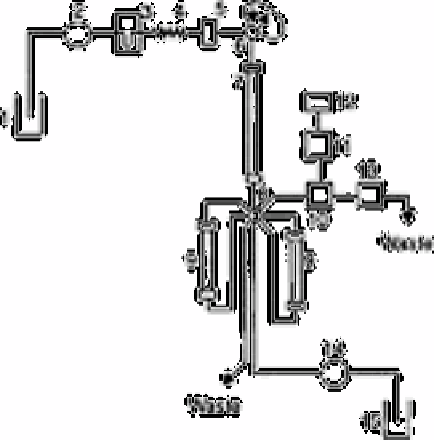Chemistry Reference
In-Depth Information
Fig. 12.8
Schematic diagram of the ion chromatograph: 1, eluent reservoir; 2,
pump; 3, pulse dampener; 4, capillary; 5, filter; 6, 6-port injection
valve; 7, analytical column; 8, 8-port valve; 9, suppressor columns;
10, conductivity cell; 11, conductivity detector; 12, recorder; 13,
syphon counter; 14, regeneration pump; 15, regeneration liquid (nitric
acid or water)
Source: Reproduced with permission from Elsevier Science [11]
The columns (precision bore polished stainless steel, id 4.5mm) and the detector cell are
surrounded by water jackets and thermostated by a thermostat to within 0.01°C. The
connecting tubing (id 0.25mm) is kept as short as possible. Low dead volume connectors
are used to minimise extracolumn peak broadening. The eluent flow rate is monitored
continuously with a calibrated siphon counter.
The column packing apparatus is outlined in Fig. 12.9. The pump is of the
reciprocating type and should attain a pressure of at least 400bar when columns have to
be packed with 10µm particles. A Milton Roy pump (Chicago, Illinois) was used. Pulse
dampening is achieved with a flow through Bourdon gauge, a resistance capillary, an
Orlita pulse dampener and another capillary in series. The stainless steel capillaries
(length 3m, id 0.25mm) ensure a nearly pulse free flow. The slurry reservoir is a thick-
walled stainless steel tube equipped with teflon sealed stainless steel nuts. The lower nut
is part of the polished precolumn (length 10cm). The internal diameter of the precolumn,
connector and column should be equal. The packed bed in the column is kept in place by
means of a thin plug of wool in a low dead volume connector.
The columns are packed according to the viscous slurry method [13]. The Zipax SAX
(5g) is suspended in 25ml of ethyleneglycol and 2.5g of AG-50W-X12 in 25ml of
isopropanol. The scurries are degassed and

Search WWH ::

Custom Search